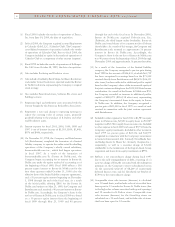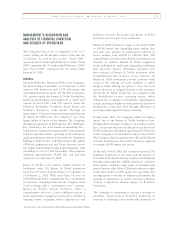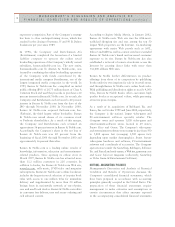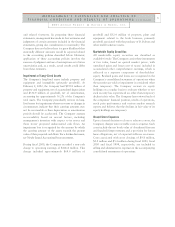Barnes and Noble 2001 Annual Report Download - page 18
Download and view the complete annual report
Please find page 18 of the 2001 Barnes and Noble annual report below. You can navigate through the pages in the report by either clicking on the pages listed below, or by using the keyword search tool below to find specific information within the annual report.
L I Q U I D I T Y AND CA P I TAL RESOURCES
Working capital requirements are generally at their
highest during the Company’s fiscal quarter ending on
or about January 31 due to the higher payments to
vendors for holiday season merchandise purchases and
the replenishment of merchandise inventories following
this period of increased sales. In addition, the Company’s
sales and merchandise inventory levels will fluctuate
from quarter to quarter as a result of the number and
timing of new store openings, as well as the amount and
timing of sales contributed by new stores.
Cash flows from operating activities, funds available
under its revolving credit facility and vendor financing
continue to provide the Company with liquidity and
capital resources for store expansion, seasonal working
capital requirements and capital investments.
C a sh Flow
Cash flows provided from operating activities were
$457.4 million, $80.5 million and $187.3 million
during fiscal 2001, 2000 and 1999, re s p e c t i v e l y. In
fiscal 2001, the increase in cash flows from operating
activities was primarily attributable to incre a s e d
accounts payable leverage and improvement in net
earnings. In fiscal 2000, the decrease in cash flows from
operating activities was primarily attributable to a
w e a k e r-than-expected holiday season which resulted
in lower net earnings and an increase in standing
inventory as well as an increase in prepaid rent due to
the fiscal year-end date. In fiscal 1999, the improvement
in cash flows was primarily due to the improvement in
net earnings.
Retail earnings before interest, taxes, depreciation and
a m o r tization (EBITDA) increased $10.8 million or 2.8%
to $392.2 million in fiscal 2001 from $381.4 million in
fiscal 2000. This improvement in EBITDA is due to the
growth in the Video Game & Entertainment Software
segment and the continuing maturation of the Barnes &
Noble stores offset by the lower gross margins in
the bookstore segment due to the increased spending by
Readers’ Advantage™ members. Total debt to re t a i l
EBITDA improved to 1.14 times in fiscal 2001 from 1.75
times in fiscal 2000 primarily due to increased cash flows
f rom operations that reduced debt incurred to fund the
C o m p a n y ’s Acquisitions. The weighted-average age per
s q u a r e foot of the Company’s 591 Barnes & Noble store s
was 5.3 years as of Febru a ry 2, 2002 and is expected to
i n c r ease to approximately 5.8 years by Febru a r y 1, 2003.
As the relatively young Barnes & Noble stores mature ,
and as the number of new stores opened during the fiscal
year decreases as a percentage of the existing store base,
the increasing operating profits of Barnes & Noble store s
a r e expected to generate a greater portion of cash flows
re q u i red for working capital, including new store
inventories, capital expenditures and other initiatives.
A d d i t i o n a l l y, due to the Barnes & Noble.com Inc. IPO
in fiscal 1999, retail cash flows are fully available to
s u p p o r t the Company’s working capital re q u i re m e n t s .
Capital St r u c t u r e
Strong cash flows from operations and a continued
emphasis on working capital management stre n g t h e n e d
the Company’s balance sheet in fiscal 2001. Share h o l d e r s ’
equity increased 14.2% to $888.1 million as of Febru a r y
2, 2002, from $777.7 million as of Febru a r y 3, 2001.
The Company has an $850.0 million senior credit facility
(the Facility), obtained in November 1997, with a
syndicate led by The Chase Manhattan Bank. The
Facility is structured as a five-year revolving credit. The
Facility permits borrowings at various interest-rate
options based on the prime rate or London Interbank
O f fer Rate (LIBOR) depending upon certain financial
tests. In addition, the agreement re q u i res the Company to
pay a commitment fee up to 0.25 percent of the unused
portion depending upon certain financial tests. The
Facility contains covenants, limitations and events of
default typical of credit facilities of this size and nature.
The amount outstanding under the Facility has been
classified as long-term debt in the accompanying
consolidated balance sheets due to both the Company’s
intent and ability to maintain principal amounts.
In fiscal 2000, the Company obtained an additional
$100.0 million senior unsecured seasonal credit facility
(seasonal credit facility) with a syndicate of banks led
by The Chase Manhattan Bank. The seasonal credit
facility, which matured on January 31, 2001, permitted
for borrowings at an interest rate based on LIBOR. In
addition, the agreement required the Company to pay a
commitment fee of 0.375 percent of the unused portion.
The seasonal credit facility was guaranteed by all
restricted subsidiaries of Barnes & Noble.
In fiscal 2001, the Company issued $300.0 million,
5.25 percent convertible subordinated notes due March
15, 2009, further strengthening its balance sheet. The
notes are convertible into the Company’s common
stock at a conversion price of $32.512 per share.
M A N A G E M E N T ’ S D I S C U S S I O N A N D A N A L Y S I S O F
F I N A N C I A L C O N D I T I O N A N D R E S U L T S O F O P E R A T I O N S c o n t i n u e d
18
























